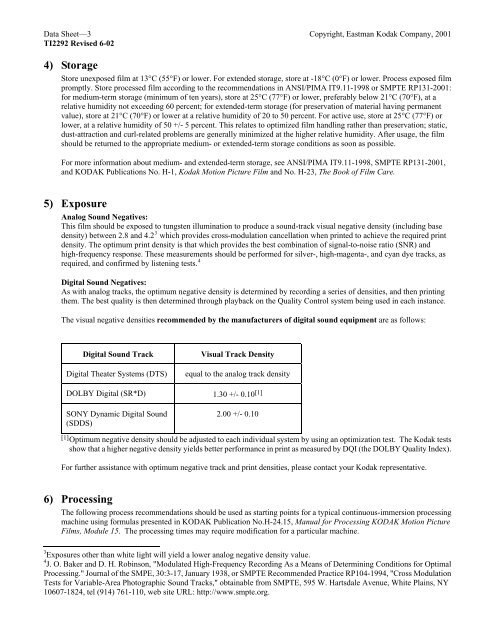KODAK Panchromatic Sound Recording Film 2374 (ESTAR)
KODAK Panchromatic Sound Recording Film 2374 (ESTAR)
KODAK Panchromatic Sound Recording Film 2374 (ESTAR)
Create successful ePaper yourself
Turn your PDF publications into a flip-book with our unique Google optimized e-Paper software.
Data Sheet—3 Copyright, Eastman Kodak Company, 2001<br />
TI2292 Revised 6-02<br />
4) Storage<br />
Store unexposed film at 13°C (55°F) or lower. For extended storage, store at -18°C (0°F) or lower. Process exposed film<br />
promptly. Store processed film according to the recommendations in ANSI/PIMA IT9.11-1998 or SMPTE RP131-2001:<br />
for medium-term storage (minimum of ten years), store at 25°C (77°F) or lower, preferably below 21°C (70°F), at a<br />
relative humidity not exceeding 60 percent; for extended-term storage (for preservation of material having permanent<br />
value), store at 21°C (70°F) or lower at a relative humidity of 20 to 50 percent. For active use, store at 25°C (77°F) or<br />
lower, at a relative humidity of 50 +/- 5 percent. This relates to optimized film handling rather than preservation; static,<br />
dust-attraction and curl-related problems are generally minimized at the higher relative humidity. After usage, the film<br />
should be returned to the appropriate medium- or extended-term storage conditions as soon as possible.<br />
For more information about medium- and extended-term storage, see ANSI/PIMA IT9.11-1998, SMPTE RP131-2001,<br />
and <strong>KODAK</strong> Publications No. H-1, Kodak Motion Picture <strong>Film</strong> and No. H-23, The Book of <strong>Film</strong> Care.<br />
5) Exposure<br />
Analog <strong>Sound</strong> Negatives:<br />
This film should be exposed to tungsten illumination to produce a sound-track visual negative density (including base<br />
density) between 2.8 and 4.2 3 which provides cross-modulation cancellation when printed to achieve the required print<br />
density. The optimum print density is that which provides the best combination of signal-to-noise ratio (SNR) and<br />
high-frequency response. These measurements should be performed for silver-, high-magenta-, and cyan dye tracks, as<br />
required, and confirmed by listening tests. 4<br />
Digital <strong>Sound</strong> Negatives:<br />
As with analog tracks, the optimum negative density is determined by recording a series of densities, and then printing<br />
them. The best quality is then determined through playback on the Quality Control system being used in each instance.<br />
The visual negative densities recommended by the manufacturers of digital sound equipment are as follows:<br />
Digital <strong>Sound</strong> Track Visual Track Density<br />
Digital Theater Systems (DTS) equal to the analog track density<br />
DOLBY Digital (SR*D) 1.30 +/- 0.10 [1]<br />
SONY Dynamic Digital <strong>Sound</strong><br />
(SDDS)<br />
2.00 +/- 0.10<br />
[1] Optimum negative density should be adjusted to each individual system by using an optimization test. The Kodak tests<br />
show that a higher negative density yields better performance in print as measured by DQI (the DOLBY Quality Index).<br />
For further assistance with optimum negative track and print densities, please contact your Kodak representative.<br />
6) Processing<br />
The following process recommendations should be used as starting points for a typical continuous-immersion processing<br />
machine using formulas presented in <strong>KODAK</strong> Publication No.H-24.15, Manual for Processing <strong>KODAK</strong> Motion Picture<br />
<strong>Film</strong>s, Module 15. The processing times may require modification for a particular machine.<br />
3 Exposures other than white light will yield a lower analog negative density value.<br />
4 J. O. Baker and D. H. Robinson, "Modulated High-Frequency <strong>Recording</strong> As a Means of Determining Conditions for Optimal<br />
Processing." Journal of the SMPE, 30:3-17, January 1938, or SMPTE Recommended Practice RP104-1994, "Cross Modulation<br />
Tests for Variable-Area Photographic <strong>Sound</strong> Tracks," obtainable from SMPTE, 595 W. Hartsdale Avenue, White Plains, NY<br />
10607-1824, tel (914) 761-110, web site URL: http://www.smpte.org.

















